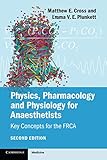Physics, pharmacology, and physiology for anaesthetists : key concepts for the FRCA / Matthew E. Cross, Emma V.E. Plunkett ; foreword to the second edition by Professor Peter Hutton,
Publisher: Cambridge ; New York : Cambridge University Press, 2014Edition: 2nd editionDescription: xvii, 419 p. : ill. ; 24 cmISBN:- 9781107615885
- QT 34 C951p 2014
| Item type | Current library | Call number | Copy number | Status | Date due | Barcode |
|---|---|---|---|---|---|---|
 Book Open Access
Book Open Access
|
Health Sciences Library | QT 34 C951p 2014 (Browse shelf(Opens below)) | 1 | Available | MBAL22066229 | |
 Book Closed Access
Book Closed Access
|
Health Sciences Library | 617.96 CRO 2 (Browse shelf(Opens below)) | 2 | Available | MBAL22066250 | |
 Book Closed Access
Book Closed Access
|
Health Sciences Library | 617.96 CRO 3 (Browse shelf(Opens below)) | 3 | Available | MBAL22066251 |
Index : p. 404-419
Contents;
Section 1: Mathematical principles
Mathematical relationships
Exponential relationships and logarithms
Integration and differentiation
Physical measurement and calibration
etc.
Section 2: Physical principles
Simple mechanics
The gas laws
Laminar flow
Turbulent flow
etc.
Section 3: Principles of special equipment
Magnetic resonance imaging
Refraction and fibre optics
Laser principles
Surgical diathermy
etc.
Section 4: Pharmacological principles
Atomic structure
Oxidation and reduction
Chemical bonds
Inorganic and organic chemistry
Isomerism
etc.
Section 5: Pharmacodynamic
Drug-receptor interaction
Affinity, efficacy and potency
Agonism and antagonism
Hysteresis
etc.
Section 6: Pharmacokinetics
Absorption, distribution and redistribution
First-pass metabolism and bioavailability
Volume of distribution
Clearance
Time constant and half life
etc.
Section 7: Respirator physiology
Lung volumes
Spirometry
Flow-volume loops
The alveolar gas equation
The shunt equation
etc.
Section 8: Cardiovascular physiology
Einthoven's triangle and axis
Cardiac action potentials
The cardiac cycle
Electrocardiographic changes
etc.
Section 9: Renal physiology
Acid-base balance
Buffers and the anion gap
Glomerular filtration rate and tubulo-glomerular feedback
Autoregulation and renal vascular resistance
The loop of Henle
etc.
Section 10: Neurophysiology
Action potentials
Muscle structure and function
Muscle reflexes
The Monro-Kelly doctrine
etc.
Section 11: Applied sciences
The stress response
Cardiopulmonary exercise testing
Pregnancy
Paediatrics
etc.
Section 12: Statistical principles
Types of data
Indices of central tendency and variability
Types of distribution
Methods of data analysis
etc.


There are no comments on this title.